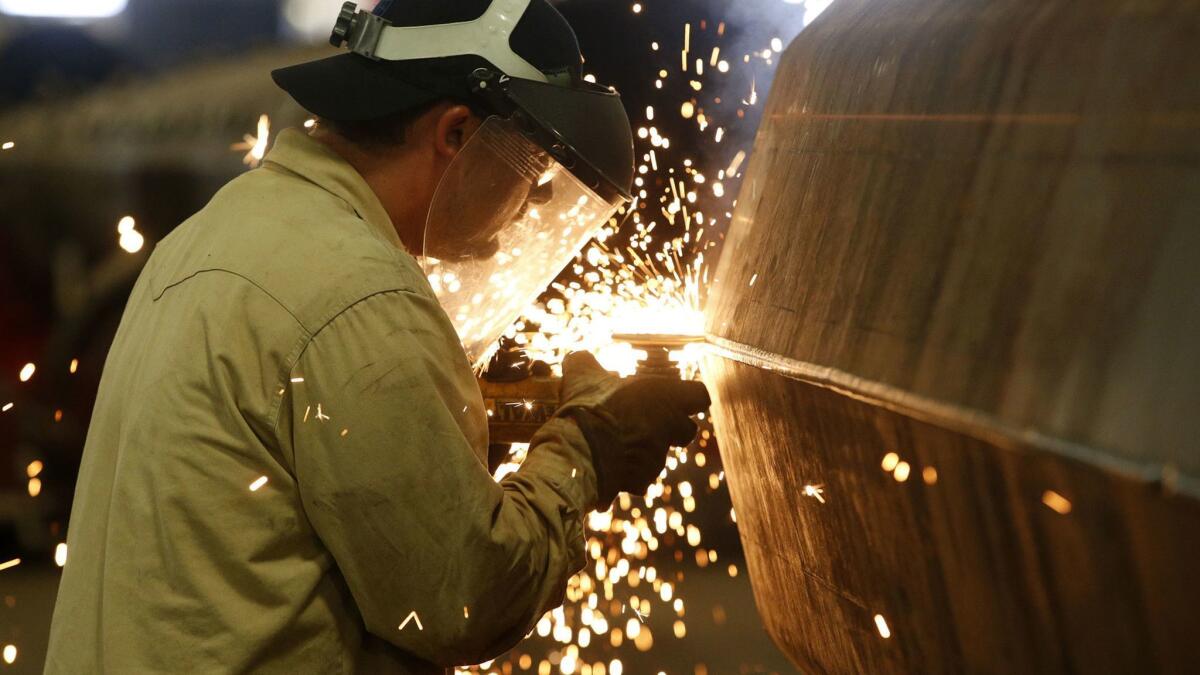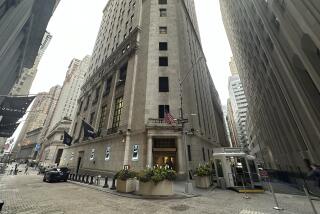Faster wage growth in strong jobs report is likely to mean more Fed interest rate hikes

Reporting from Washington — Wage growth accelerated last month to its best year-over-year rate since 2009 in a strong jobs report released Friday, increasing the likelihood that Federal Reserve officials will keep hiking a key interest rate to head off higher inflation.
The Labor Department reported that the U.S. added 201,000 net new jobs in August, up from a downwardly revised 147,000 the previous month. The unemployment rate held steady at 3.9%, in large part because the labor force surprisingly shrank by nearly half a million people, the biggest drop in four years.
But the focus at this stage in the long recovery is on wages, and the news there was good — with the caveat that wage growth remained sluggish when adjusted for rising inflation.
Average hourly earnings increased by 10 cents in August, the most since December, to $27.16. That helped push the year-over-year growth to 2.9%, approaching the 3% annual growth economists have been hoping for. The figure was 2.7% for the year ended July 31.
“As the labor market tightens, businesses are raising pay to attract new workers and retain their current ones,” said Gus Faucher, chief economist at PNC Financial Services Group. “Wage growth will accelerate further as firms raise pay to recruit workers. Stronger wage growth will bolster consumer spending into 2019.”
But inflation also has been rising. The consumer price index increased 2.9% year-over-year in July, the most recent figures available, meaning the actual spending power of Americans hasn’t really budged.
Inflation-adjusted wage growth — known as real wages — remains sluggish and below its pace in 2015, when inflation was running much lower.
Still, investors saw Friday’s wage data and the other strong jobs numbers as leading to higher interest rates.
The Dow Jones industrial average dropped about 100 points at the open Friday but recovered somewhat . The index closed down 79.33 points, or 0.3%, at 25,916.54.
Massud Ghaussy, a senior analyst at Nasdaq, said the report “provides the Fed more ammunition to keep raising rates.”
Based on the futures market, investors are almost certain that central bank policymakers will inch up their benchmark federal funds rate another 0.25 percentage point when they meet Sept. 25-26. And there was about a 74% chance the Fed will hike the rate again in December, according to the FedWatch tool of the CME Group futures exchange.
President Trump has criticized the Fed for raising interest rates, complaining that higher rates would slow economic growth. But Fed policymakers are trying to inch up the still historically low rate, which now sits at a range between 1.75% and 2%, to keep improving economic conditions from causing potentially debilitating high inflation.
Trump touted the jobs report and wage growth during a fundraising event in Fargo, N.D.
“It’s like the best wage number we’ve had in many, many years,” he said. “People are starting to be able to live.”
Trump’s top economic advisor, Larry Kudlow, pointed to a report this week by the White House Council of Economic Advisors that said traditional wage measures, such as the one used in the monthly Labor Department jobs report, understate the growth. The report cited several reasons, including failure to account for one-time bonuses and demographic changes in which higher paid workers are retiring and being replaced by people with less experience who receive lower wages.
The CEA report also said it was better to measure inflation using the Commerce Department’s price index for personal consumption expenditures, which is the Fed’s preferred measure. That figure tends to run lower than the consumer price index and was 2.3% year-over-year in July.
Friday’s jobs report included revisions showing overall labor market gains were a combined 50,000 lower for June and July. That lowered the average monthly job growth this year a bit to 207,000, which still would be the best since 2015.
The gains came in several industries: professional and business services; healthcare; wholesale trade; transportation and warehousing; and mining. But in a discouraging sign, the manufacturing sector — on an accelerated upswing since 2017 — lost jobs for the first time in more than a year.
Factories shed 3,000 positions in August after an 18,000-job gain the previous month amid a trade war triggered by Trump. The president told reporters Friday that tariffs on another $267 billion of imports from China are “ready to go on short notice if I want.”
Michael Gapen, chief U.S. economist at Barclays, said the drop in manufacturing jobs last month “could be a sign that protectionism is taking its toll.”
Like the manufacturing decline, the big drop in the size of the labor force was unsettling — although economists said both could be just one-month anomalies.
The departure of 469,000 people from the workforce was the largest since 2014 and pushed down the percentage of working-age Americans who have or are looking for employment to 62.7%.
Economists have been encouraged that the labor force has been growing in recent years, indicating workers on the sidelines are optimistic about finding jobs.
UPDATES:
2:15 p.m.: This article was updated with comments by President Trump and Michael Gapen of Barclays and additional details.
8:15 a.m.: This article was updated with staff reporting and analysis.
This article was originally published at 5:35 a.m.
More to Read
Inside the business of entertainment
The Wide Shot brings you news, analysis and insights on everything from streaming wars to production — and what it all means for the future.
You may occasionally receive promotional content from the Los Angeles Times.











